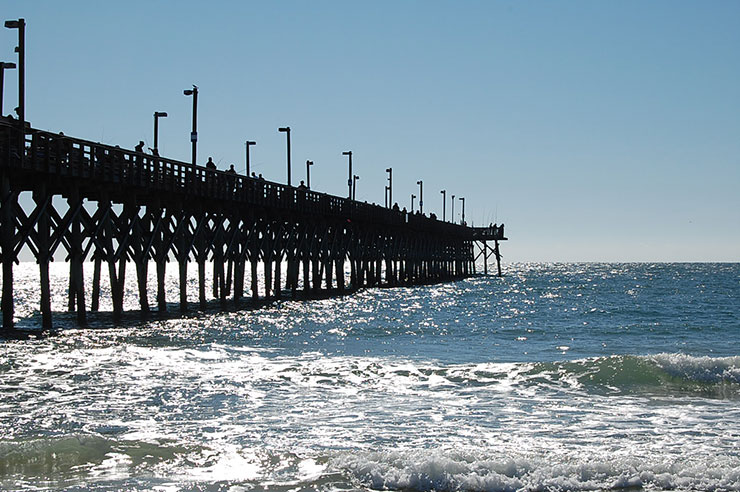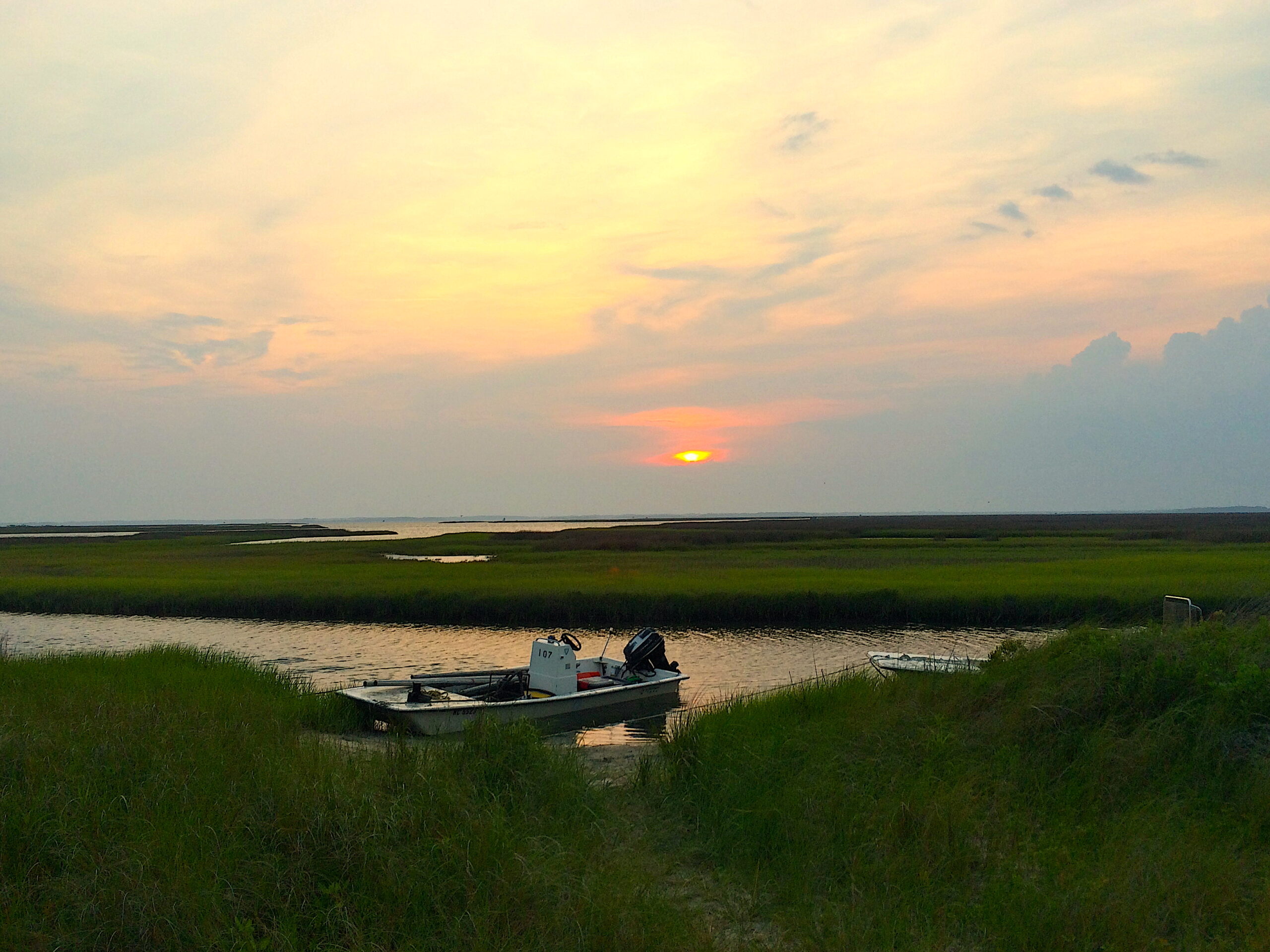Beyond the Boundaries: Indonesian Officials Take Home Coastal Lessons

Surf City on Topsail Island is a long way from the beaches of Bali, or any of the 17,500 islands that make up Indonesia.
But lessons learned along the North Carolina coast will factor in discussions this year in Indonesia, where pivotal coastal legislation is being considered.
“Good coastal management is important to us all,” Surf City Mayor Zander Guy suggests to a pair of senior Indonesian officials on a recent visit hosted by North Carolina Sea Grant.
The Indonesians chose to visit North Carolina because of the state’s “robust and dynamic” coastal programs, explains Soestrisno Sosroprajitno, vice chair of the National Parliament’s Environmental Commission.
The trip halfway round the world is fruitful, says Widi Pratikto, Indonesia’s director general of coasts and small islands in the Ministry of Marine Affairs and Fisheries.
“In Indonesia, we are trying to establish our own “Sea Grant” Program called Program Kemitraan Bahari (Sea Partnership Program). Our visit to Hawaii, North Carolina, Washington, D.C., Rhode Island, and Halifax, Nova Scotia, strengthens our belief that through such a program, we will succeed in developing our nation’s coastal ocean programs in order to achieve economic development in sustainable ways,” he adds.
Pratikto is already familiar with North Carolina, having received his doctorate in civil engineering from North Carolina State University in 1992. His coastal research here focused on natural approaches for mitigating dune erosion.
For the past year, he has led a variety of efforts in his home country, including integrated coastal management, small islands management, coastal spatial planning, marine conservation, economic development and empowerment within coastal communities.
He works closely with the Indonesia Coastal Resources Management Project (CRMP). A joint project of the Indonesian government and the U.S. Agency for International Development, CRMP is implemented by the University of Rhode Island’s Coastal Resources Center.
“We have learned a lot about local coastal zone management in different places, such as Hawaii and North Carolina,” he says. Topics include how to utilize “set backs” and “retreat” methods.
“We now are more convinced that through decentralization of control over coastal resources, our coastal beaches will be managed in better ways,” he adds. “However, we can be successful only by increasing the capacity of our government staff, coastal residents and citizens and nongovernmental organizations, etc.”
Science and Policy
Sosroprajitno, who received his doctorate in agricultural economics from the University of Hawaii, explains that he offers a dual perspective.
“I have two feet — one in science and one in politics,” he says. As vice chair of the commission in parliament that includes marine affairs, he will lead much of the debate on new coastal legislation.
Blending science and policy is a challenge for Indonesia. After decades of authoritarian rule, the Indonesian Parliament is moving the country toward a decentralized government.
The political changes are not so dramatic in North Carolina. But, connections between science and policy decisions are equally important here.
“Regulatory agencies benefit from working with university researchers. Sea Grant provides that critical link through education and outreach programs,” says Walter Clark, Sea Grant’s coastal law and policy specialist.
That format is a model for many countries. “Having a Sea Grant Program will be nothing short of phenomenal in Indonesia,” says Maurice Knight, director of CRMP.
The U.S. tour reveals that while Sea Grant and Coastal Zone Management are national efforts, states must develop programs that respond to unique needs.
“Indonesia is very eager to begin these types of local management approaches,” says Stacey Tighe, CRMP senior technical advisor.
Indonesia has the second longest coastline in the world with 82,000 kilometers of coast. More than 60 percent of Indonesia’s 220 million people live within 50 kilometers of the coast.
The country’s vast marine resources include more than 70 genera of hard corals — and the island chain is touted as the “bull’s eye” of highest marine biodiversity on earth. However, only about 7 percent of Indonesia’s coral reefs are considered in pristine condition.
About 24 percent of Indonesia’s gross domestic product comes from marine products and industries. As traditional forest resources are depleted, emphasis is shifting to marine and coastal resources.
N.C. Itinerary
On Topsail Island, the Indonesian group meets not only with the Surf City officials, but also with representatives of the N.C. Division of Coastal Management (DCM). Topics include erosion rates and setbacks, even storm-related emergency policies.
Public access is another focus, both on the oceanfront and along the sounds that are experiencing increased development. “Communities are buying tracts of land for everyone to enjoy,” explains DCM’s James Rosich as the group stops at a newly designated soundfront park in Surf City. “Access is a priority,” he adds.
The Indonesian officials are interested in the “public trust” doctrine that supports many coastal management decisions here. Indonesian islands increasingly are being eyed by outside investors looking to develop shrimp farms or to establish scuba diving and adventure travel outposts.
Coastal economic development opportunities — and challenges — are the topics during stops in Morehead City and New Bern.
The visitors meet Don Cross of Pamlico Packing, who is working with Sea Grant to develop “value-added” products in addition to the traditional seafood commodities. The group also samples new seafood dishes tested in the NC State Seafood Laboratory with volunteers known as Nutrition Leaders.
Penny Hooper, who leads the mariculture program at Carteret Community College, describes the sequence that trains students for either immediate entry into the aquaculture industry or for further education. She also has many questions for the guests. “I am in awe of the task they have ahead of them,” Hooper says.
“They recognize that education is an important part of any of their projects,” she adds. “And that the keys to sustainability for seafood are good regulations — and aquaculture.”
The group then heads to Smyrna to see Mark Hooper’s shellfish mariculture operation that utilizes the state’s program to lease bottom areas of Core Sound.
The group discusses fishery issues with Preston Pate, director of the N.C. Division of Marine Fisheries (DMF), and Jerry Schill, president of the N.C. Fisheries Association.
Schill cites the Sea Grant role in reducing bycatch in shrimp trawls. Sea Grant worked with the fisheries association and the DMF to develop and test “bycatch reduction devices,” known as BRDs, well ahead of other states.
“The fishermen started using them — and the BRDs worked,” says Schill, who noted the wide acceptance because the fishing community was involved. Eventually the state required the gear already in use.
The tour concludes in Raleigh, including a visit to the NC State “Fish Barn,” an aquaculture facility that provides scientific groundwork for Sea Grant recommendations to industry. On campus, they meet with civil engineering faculty to learn the latest in coastal engineering.
The group then heads to Washington, D.C., to meet with National Oceanic and Atmospheric Administration officials, including Ronald Baird, director of the National Sea Grant College Program.
Continued Connections
Each stop on the tour offers lessons not only for the Indonesian Parliament, but also for government agencies and universities.
Russ Lea, vice president for research for the University of North Carolina system, explains that university extension provides immediate access to the latest information. “The universities are where the action is,” says Lea, who met with the Indonesian officials.
“There’s a rapid transfer of knowledge through the extension program to the stakeholders — right as the scientific breakthroughs are being generated,” he adds.
The direct connection encourages an enthusiasm among coastal partners in North Carolina that is “infectious,” says Tighe. “To see the strong role of advisory boards and citizens councils and volunteerism makes a real impression of how stakeholders can be involved in governance,” she adds.
And the international exchange is likely to continue.
“We already have had discussions of potential cross visits and new partnerships that will surely evolve into strong, formal and hopefully mature networks over the years ahead — as the stewardship of people and the ocean planet bring families together with common interests,” Tighe says.
Ronald G. Hodson, North Carolina Sea Grant director, adds that the experience is a two-way street.
“We learn as they explain the challenges — and opportunities — that Indonesia is facing,” Hodson says.
This article was published in the Winter 2003 issue of Coastwatch.
For contact information and reprint requests, visit ncseagrant.ncsu.edu/coastwatch/contact/.
- Categories:


